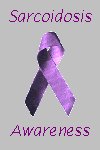|
|
|
![]()
Information Page

|
Sarcoidosis is a disease which occurs when areas of inflammation grow in different organs of the body. Very small growths called granulomas are associated with it and occur in the lungs, lymph nodes, eyes, skin, and spleen. These growths may clear up on their own or cause permanent damage. The cause of sarcoidosis is unknown. For some reason the body's immune system acts as if it needs to fight an invader. Sarcoidosis occurs more frequently in Caucasians of European descent and among African-Americans. About 10-40 out of every 100,000 people develop sarcoidosis. It is most common in young people between the ages of 20 and 40. Sarcoidosis is not contagious. What are the signs and symptoms?People with sarcoidosis may have no symptoms, only vague symptoms of a general nature such as weight loss and fever, or symptoms associated with a specific organ, usually the lungs. More than
|
one organ can be involved. Up to half of sarcoidosis patients have no symptoms when the illness is diagnosed. Thus, the diagnosis can be difficult to make. Signs and symptoms associated with specific organ involvement can include the following: Lungs Lymph Nodes Eyes Skin |
These deeper nodules are generally found on the legs and are often associated with arthritis (from sarcoidosis as well). Bone Spleen and Liver Heart Brain and Nervous System
|
How is the diagnosis made?The inflamed microscopic growths (granulomas) seen in the lungs with sarcoidosis are similar to those in other diseases such as tuberculosis, fungal diseases, berylliosis, and farmer's lung. Because of this, a careful evaluation is necessary to make a diagnosis. Only after the known causes of granulomas have been "ruled out" is the diagnosis of sarcoidosis made. An evaluation to detect sarcoidosis should include the following: |
Thorough Medical Examination Chest X-Ray |
Pulmonary Function Tests |
|
Tissue biopsy Bronchoalveolar Lavage |
Eye Examination Serum Angiotensin Converting Enzyme Level (S.A.C.E.) Computerized Tomography (CT Scan) Gallium Scan |
body to see where the radioactive material has collected. Although not needed in all cases, gallium scanning can help show sarcoidosis in many organs, including the lungs, salivary glands, bone, spleen, and liver. This can lessen the need for tissue biopsies of all these organs. Monitoring of Calcium Levels in the Blood and Urine Kveim Test |
What is the treatment?Not everyone with sarcoidosis will need treatment. One half to three quarters of the people diagnosed with sarcoidosis improve without treatment. Those who do not are usually placed on medication to reduce inflammation. Many people will recover, but a some will get worse despite treatment. The goal of treatment is to maintain good lung function, lessen symptoms, and prevent organ damage. Corticosteroids, which work against inflammation, are the main treatment. Generally, prednisone (a tablet) is given daily or every other day, depending on the symptoms. It can decrease symptoms, improve lung function, decrease S.A.C.E. levels, reduce granuloma formation, and possibly, lessen scarring of the lungs. Prednisone can be associated with a number of side effects. Because of this, people on steroids should be carefully monitored by a doctor. The potential benefits from treatment usually outweigh the risks from the medication side effects.
|
What Other Treatment is Used?The use of inhaled steroids (such as Azmacort®, Aerobid®, Vanceril®, Beclovent®) is also being tried. Although still considered experimental, this form of treatment may be effective in some people, and it has a lower risk of steroid side effects. When steroids can't be used, other medications can be tried. These other medications are not used often, since their effect on sarcoidosis is not well understood and not predictable. They too can have side effects. These medications include: indomethacin, azathioprine, chloroquine, methotrexate, clyclosporine, and levamisole. For a small percentage of people who develop chronic, progressive sarcoidosis, pulmonary rehabilitation and oxygen therapy may be needed. One important thing a person can do to improve the outcome of this disease is to see a doctor when the symptoms first appear. This can help prevent damage to the lungs, eyes, heart, and other organs. People with sarcoidosis can, like others, develop lung disease from smoking. Therefore, it is also important not to smoke. |
Source: National Jewish Medical and Research Center
Sarcoidosis Vasculitis and Diffuse Lung Diseases-1999 Report
Here is an excerpt
Influence of ethnicity and genetic factors on prognosis
The clinical course and prognosis of sarcoidosis is influenced by ethnic and genetic factors. African-American patients appear to have a higher rate of extrapulmonary involvement, chronic uveitis, lupus pernio, cystic bone lesions, chronic progressive disease, worse long-term prognosis, and higher rate of relapses. Several studies have suggested that human leukocyte antigen (HLA) markers reflect prognosis and site(s} of organ involvement. These studies are not definitive and additional studies are required to elucidate the role of HLA markers on the prognosis and clinical expression of sarcoidosis.
Free email

Want to get your own free email account you@sarcoidosis.every1.net? Sign up below or log in if already a member.
Or...go directly to our free email site: Go To Sarcoidosis Family Foundation Free Email Site
|
|||||||


©2001 Sarcoidosis Family Foundation. All Rights Reserved.
All information believed to be accurate, however, it is not guaranteed.